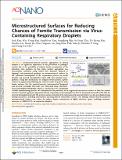| dc.contributor.author | Kim, Seok | |
| dc.contributor.author | Kim, Woo Young | |
| dc.contributor.author | Nam, Sang-Hoon | |
| dc.contributor.author | Shin, Seunghang | |
| dc.contributor.author | Choi, Su Hyun | |
| dc.contributor.author | Kim, Do Hyeog | |
| dc.contributor.author | Lee, Heedoo | |
| dc.contributor.author | Choi, Hyeok Jae | |
| dc.contributor.author | Lee, Eungman | |
| dc.contributor.author | Park, Jung-Hyun | |
| dc.contributor.author | Jo, Inho | |
| dc.contributor.author | Fang, Nicholas Xuanlai | |
| dc.contributor.author | Cho, Young Tae | |
| dc.date.accessioned | 2021-10-05T13:55:47Z | |
| dc.date.available | 2021-10-05T13:55:47Z | |
| dc.date.issued | 2021-08 | |
| dc.date.submitted | 2021-02 | |
| dc.identifier.issn | 1936-0851 | |
| dc.identifier.issn | 1936-086X | |
| dc.identifier.uri | https://hdl.handle.net/1721.1/132715 | |
| dc.description.abstract | Evaporation-induced particle aggregation in drying droplets is of significant importance in the prevention of pathogen transfer due to the possibility of indirect fomite transmission of the infectious virus particles. In this study, particle aggregation was directionally controlled using contact line dynamics (pinned or slipping) and geometrical gradients on microstructured surfaces by the systematic investigation of the evaporation process on sessile droplets and sprayed microdroplets laden with virus-simulant nanoparticles. Using this mechanism, we designed robust particle capture surfaces by significantly inhibiting the contact transfer of particles from fomite surfaces. For the proof-of-concept, interconnected hexagonal and inverted pyramidal microwall were fabricated using ultraviolet-based nanoimprint lithography, which is considered to be a promising scalable manufacturing process. We demonstrated the potentials of an engineered microcavity surface to limit the contact transfer of particle aggregates deposited with the evaporation of microdroplets by 93% for hexagonal microwall and by 96% for inverted pyramidal microwall. The particle capture potential of the interconnected microstructures was also investigated using biological particles, including adenoviruses and lung-derived extracellular vesicles. The findings indicate that the proposed microstructured surfaces can reduce the indirect fomite transmission of highly infectious agents, including norovirus, rotavirus, or SARS-CoV-2, via respiratory droplets. | en_US |
| dc.language.iso | en | |
| dc.publisher | American Chemical Society (ACS) | en_US |
| dc.relation.isversionof | http://dx.doi.org/10.1021/acsnano.1c01636 | en_US |
| dc.rights | Creative Commons Attribution-NonCommercial-NoDerivs License | en_US |
| dc.rights.uri | http://creativecommons.org/licenses/by-nc-nd/4.0/ | en_US |
| dc.source | ACS | en_US |
| dc.title | Microstructured Surfaces for Reducing Chances of Fomite Transmission via Virus-Containing Respiratory Droplets | en_US |
| dc.type | Article | en_US |
| dc.identifier.citation | Kim, Seok et al. "Microstructured Surfaces for Reducing Chances of Fomite Transmission via Virus-Containing Respiratory Droplets." ACS Nano 15, 9 (August 2021): 14049−14060. © 2021 The Authors | en_US |
| dc.contributor.department | Massachusetts Institute of Technology. Department of Mechanical Engineering | en_US |
| dc.relation.journal | ACS Nano | en_US |
| dc.eprint.version | Final published version | en_US |
| dc.type.uri | http://purl.org/eprint/type/JournalArticle | en_US |
| eprint.status | http://purl.org/eprint/status/PeerReviewed | en_US |
| dc.date.updated | 2021-10-04T16:18:41Z | |
| dspace.orderedauthors | Kim, S; Kim, WY; Nam, S-H; Shin, S; Choi, SH; Kim, DH; Lee, H; Choi, HJ; Lee, E; Park, J-H; Jo, I; Fang, NX; Cho, YT | en_US |
| dspace.date.submission | 2021-10-04T16:18:43Z | |
| mit.journal.volume | 15 | en_US |
| mit.journal.issue | 9 | en_US |
| mit.license | PUBLISHER_CC | |
| mit.metadata.status | Complete | en_US |
